History
Towards the end of 1963, it was found that the bells of the cathedral, which were hung in the central tower, needed an overhaul, and ringing was suspended. In 1965, George Pace, the architect to York Minster, was commissioned to prepare a report. He recommended that the bells be recast and hung in a new bell frame. The installation and appropriate hanging of the bells presented several difficulties: access to the tower was difficult, the installation was potentially expensive and the new frame could not be installed in an ideal manner without obscuring the upper arches and galleries at the crossing, which were considered important architectural features. Pace recommended that consideration should be given to the building of a separate bell tower in the southeast corner of the churchyard. [1]
The recommendation was accepted by the Dean and Chapter in 1968, and Pace was commissioned to design the tower. The design was shown at the 1969 Royal Academy summer exhibition. The tower was named after the dean, Revd G. W. O. Addleshaw. [2] The foundation stone of the new tower was laid on 16 June 1973 by Lord Leverhulme, Lord Lieutenant of Cheshire. [1] The engineer for the project was Ove Arup and Partners, and the builders were A. Monk and Company, and Frankipile Limited. Pile foundations were necessary because the tower was built on the site of an old burial ground, and the sandstone bedrock was near the surface. [2]
Nine of the bells in the central tower of the cathedral were removed in February 1968 and were recast by John Taylor and Company of Loughborough into a ring of twelve bells and a flat sixth. Two bells were left in the cathedral tower, one cast by Henry Oldfield in 1606, and one cast by William Clibury in 1626. The bells were installed in the new tower towards the end of 1974, with the first trial ring on 23 October 1974. The bells were rung for a wedding for the first time on 26 February 1975, the bride being a member of the Grosvenor family. The tower was formally opened on 25 June 1975, by the Duke of Gloucester. For the occasion, each bell was rung separately by a ringer from one of thirteen different towers in the Chester area. The ceremonies concluded with a peal of Kent Treble Bob Maximus. [1] [3]
The ringing chamber of the tower was refurbished in 2008. The tower is the headquarters of the Chester Diocesan Guild of Church Bell Ringers. [2]

The Cathedral Church of the Holy Trinity,Saint Peter, Saint Paul and Saint Swithun, commonly known as Winchester Cathedral, is the cathedral of the city of Winchester, England, and is among the largest of its kind in Northern Europe. The cathedral is the seat of the Bishop of Winchester and is the mother church for the ancient Diocese of Winchester. It is run by a dean and chapter, under the Dean of Winchester.

Change ringing is the art of ringing a set of tuned bells in a tightly controlled manner to produce precise variations in their successive striking sequences, known as "changes". This can be by method ringing in which the ringers commit to memory the rules for generating each change, or by call changes, where the ringers are instructed how to generate each change by instructions from a conductor. This creates a form of bell music which cannot be discerned as a conventional melody, but is a series of mathematical sequences.

The Church of St Mary the Virgin, widely known as St Mary Redcliffe, is the main Church of England parish church for the Redcliffe district of the city of Bristol, England. The first reference to a church on the site appears in 1158, with the present building dating from 1185 to 1872. The church is considered one of the country's finest and largest parish churches as well as an outstanding example of English Gothic architecture. The church is so large it is sometimes mistaken for Bristol Cathedral by tourists. The building has Grade I listed status, the highest possible category, by Historic England.
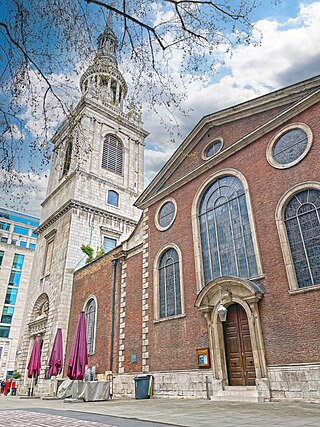
The Church of St Mary-le-Bow is a Church of England parish church in the City of London, England. Located on Cheapside, one of the city's oldest thoroughfares, the church was founded in 1080, by Lanfranc, Archbishop of Canterbury. Rebuilt several times over the ensuing centuries, the present church is the work of Sir Christopher Wren, following the Great Fire of London (1666). With its tall spire, it is still a landmark in the City of London, being the third highest of any Wren church, surpassed only by nearby St Paul's Cathedral and St Bride's, Fleet Street. At a cost of over £15,000, it was also his second most expensive, again only surpassed by St Paul's Cathedral.

The Cathedral Church and Minor Basilica of Saint Patrick is the cathedral church of the Roman Catholic Archdiocese of Melbourne in Victoria, Australia, and seat of its archbishop, currently Peter Comensoli.
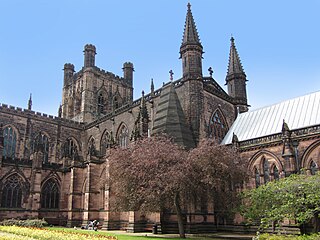
Chester Cathedral is a Church of England cathedral and the mother church of the Diocese of Chester. It is located in the city of Chester, Cheshire, England. The cathedral, formerly the abbey church of a Benedictine monastery dedicated to Saint Werburgh, is dedicated to Christ and the Blessed Virgin Mary. Since 1541, it has been the seat of the Bishop of Chester.

The Cathedral Church and Minor Basilica of the Immaculate Mother of God, Help of Christians is the cathedral church of the Roman Catholic Archdiocese of Sydney and the seat of the Archbishop of Sydney, currently Anthony Fisher OP. It is dedicated to the "Immaculate Mother of God, Help of Christians", Patroness of Australia and holds the title and dignity of a minor basilica, bestowed upon it by Pope Pius XI on 4 August 1932.

St George's Cathedral is the principal Anglican church in the city of Perth, Western Australia, and the mother-church of the Anglican Diocese of Perth. It is located on St Georges Terrace in the centre of the city.

St Mary's Church is located on Overleigh Road in Handbridge, an area south of the River Dee, in the city of Chester, Cheshire, England. It is also known as the Church of St Mary-without-the-Walls, which was to distinguish it from Church of St Mary-on-the-Hill across the River Dee within the city walls. The church is recorded in the National Heritage List for England as a designated Grade II* listed building. It is an active Anglican parish church in the diocese of Chester, the archdeaconry of Chester and the deanery of Chester.

Holy Trinity Church, Capenhurst is in the village of Capenhurst, Cheshire, England. The church is recorded in the National Heritage List for England as a designated Grade II listed building. It is an active Anglican parish church in the diocese of Chester, the archdeaconry of Chester and the deanery of Wirral South. Its benefice is combined with that of St Oswald, Backford.
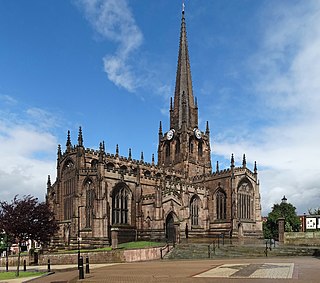
The Minster Church of All Saints or Rotherham Minster is the Anglican minster church of Rotherham, South Yorkshire, England. The Minster is a prominent example of Perpendicular Gothic architecture and various architectural historians have rated it highly. Nikolaus Pevsner describes it as "one of the largest and stateliest churches in Yorkshire", Simon Jenkins states it is "the best work in the county", and Alec Clifton-Taylor calls it the "glory of Rotherham". With its tall spire, it is Rotherham's most predominant landmark, and amongst the tallest churches in Yorkshire.

The Church of St Peter and St Paul is the Church of England parish church for the village of South Petherton, Somerset, England. The present church is a large and imposing cruciform-shaped structure constructed on the site of an earlier Saxon Minster, with the majority of the building dating from the 13th to 15th centuries; consequently, the building is Grade I listed.
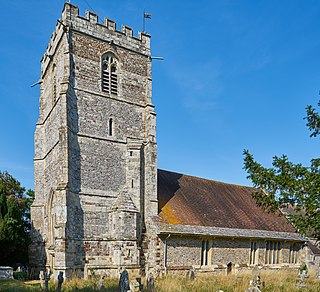
Cranborne Priory is a former priory church in the village of Cranborne, Dorset, England. Founded in 980 as Cranborne Abbey, it became a priory in 1102, remaining that way until it was dissolved in 1540. The tower, nave and aisles from the priory survive to form the Church of St Mary and St Bartholomew, the parish church of Cranborne. The building, which has fragments from the 12th century, is designated a Grade I listed building.

St Mary's Church is the main Church of England parish church for the areas of Portsea and Fratton, both located in the city of Portsmouth, Hampshire. Standing on the oldest church site on Portsea Island, the present building, amongst the largest parish churches in the country, has been described as the "finest Victorian building in Hampshire". It is at least the third church on the site and has been designated a Grade II* listed building by Historic England. Former regular worshippers here have included Charles Dickens, Isambard Kingdom Brunel, and Cosmo Lang.

St Edmund's Church, Southwold is a Grade I listed parish church in the Church of England in Southwold, Suffolk.

St Peter's Church is in St Peter's Road, Rock Ferry, Birkenhead, Wirral, Merseyside, England. It is an active Anglican parish church in the deanery of Birkenhead, the archdeaconry of Chester, and the diocese of Chester. The church is designated by English Heritage as a Grade II listed building.

Evesham Bell Tower is the freestanding belfry for the town of Evesham, Worcestershire. Originally founded in 1207 by Adam Sortes, the present tower, the fourth to stand on the same site, was founded and built by Clement Lichfield, Abbot of Evesham as the bell tower for Evesham Abbey in the 16th century. It is the only part of the abbey complex to survive wholly intact.
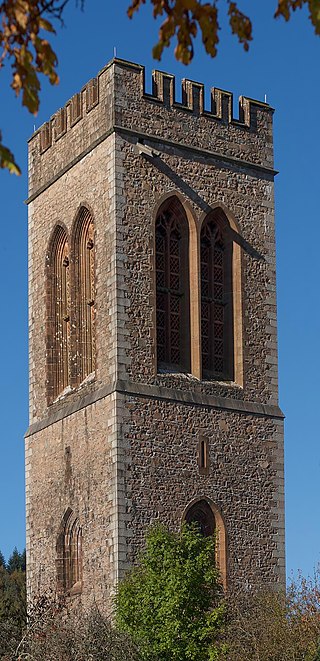
The Duke's Tower, also known as Inveraray Bell Tower, is the detached bell tower of All Saints' Church, Inveraray, Argyll and Bute, Scotland. Standing 126 feet (38 m) high on the shores of Loch Fyne, it is a landmark for miles and amongst the most notable bell towers in the United Kingdom. The tower was built as a memorial to members of the Clan Campbell who died in the First World War. It is Category A listed by Historic Environment Scotland, the highest possible rating.

The Church of St Michael and All Angels is the main Church of England parish church for the suburb of Heavitree, located in the city of Exeter, Devon. The present building is a large and imposing Gothic Revival structure dating back to the 19th century but there has been a church on the site since Saxon times. Designated as a Grade II* listed building by Historic England, the church is notable for its Victorian architecture, tall tower and proximity to the 'Heavitree Yew', an ancient common yew tree within the churchyard amongst the oldest in the county.

The Norman Tower, also known as St James' Gate, is the detached bell tower of St Edmundsbury Cathedral, Bury St Edmunds, Suffolk. Originally constructed in the early 12th century, as the gatehouse of the vast Abbey of Bury St Edmunds, it is one of only two surviving structures of the Abbey, the other being Abbey Gate, located 150 metres to the north. The Abbey itself lies in ruins, approximately 200 metres to the east. As a virtually unaltered structure of the Romanesque age, the tower is both a Grade I listed building and a Scheduled Ancient Monument. The tower is considered amongst the finest Norman structures in East Anglia.




















